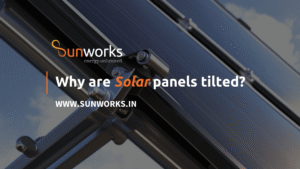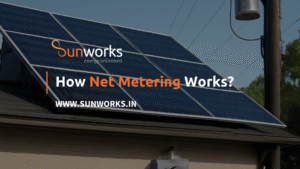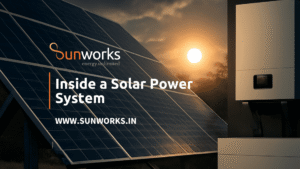
Why Solar Panels Are Tilted – Explainer
Home » Why Solar Panels Are Tilted – Explainer
Why Solar Panels Are Tilted – Explainer
Solar energy is becoming the go-to solution for clean and sustainable power, particularly in countries like India, where sunshine is abundant. But if you’ve observed solar systems closely, you’ll notice they’re rarely installed flat. Instead, solar panels are tilted and aligned in specific directions — and it’s not by accident.
This article explains why tilt and orientation matter and how they can significantly influence your system’s performance.
The Science Behind the Tilt
The tilt angle of a solar panel is the angle between the panel and the ground, essential for maximizing energy efficiency. The goal of this tilt is to ensure that the sun’s rays strike the panel as directly as possible, especially during peak sunlight hours. When sunlight hits the photovoltaic (PV) cells at a perpendicular angle, they absorb maximum energy, resulting in higher electricity output.
An improper tilt angle can lead to reflection losses and reduced efficiency. That’s why solar installers calculate the perfect tilt based on geography, roof type, and seasonal sunlight variation.
Key Reasons Why Tilt Matters
Here are the main reasons solar installers carefully calculate the right tilt angle:
- Maximizes Solar Energy Output. A correctly tilted panel ensures that maximum solar irradiance hits the surface. This significantly increases energy production over the year, especially in locations with varying sun paths through seasons.
- Improves Self-Cleaning Panels installed at a tilt allow rainwater to wash away dust, bird droppings, and debris. A flat panel, on the other hand, might trap dirt, which reduces efficiency and increases cleaning costs.
- Reduces Dust and Water Accumulation. Tilted panels prevent dust from piling up and blocking sunlight. Similarly, water runoff is more efficient, reducing corrosion risks.
- Optimizes ROI and Space Usage. A well-angled system can generate more energy per panel, allowing property owners to get better returns from limited rooftop space.
Factors That Influence Tilt Angle
The ideal tilt angle isn’t the same for everyone. It depends on:
- Geographic location – In India, for example, solar panels are generally tilted at angles close to the latitude of the installation location.
- Purpose of installation – Whether you’re optimizing for summer performance or a year-round average.
- Mounting structure – RCC rooftops often use fixed-tilt structures, while ground-mount installations can be adjusted seasonally.
Final Thoughts
Whether you’re installing panels for your home, business, or industrial facility, the right tilt angle can make or break your system’s efficiency. It’s not just about placing solar panels on a roof — it’s about engineering them for maximum yield. Always consult experienced solar EPC providers like SunWorks Energy Private Limited to ensure your system is designed for optimal performance, durability, and long-term returns.
Ready to optimize your roof’s potential?
Visit www.sunworks.in or connect with us to design a solution that’s smart, scalable, and sun-powered.
Latest Blogs


Net Metering – Solar Blog

SunWorks Quality Promise

Inside a Solar Power System

Solar Inverter – The Brain of your Solar System
